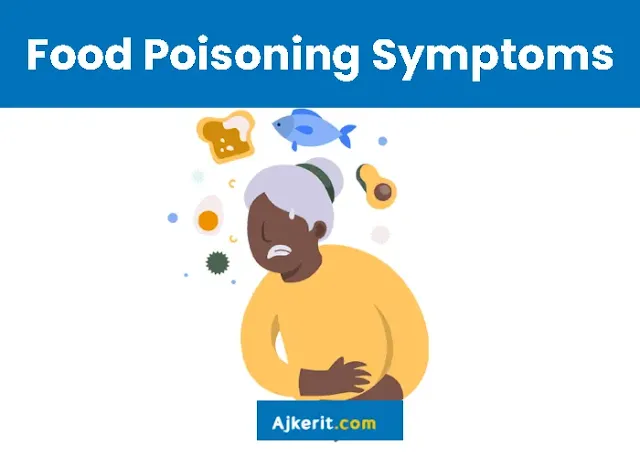Food Poisoning Symptoms
Food Poisoning Symptoms - Food poisoning is also known as foodborne illness, and this is caused by several microorganisms, which results in diarrhea and abdominal discomfort. In this post, we'll talk about the symptoms, diagnosis, and treatment of food poisoning.
আরো পড়ুন -
রবি কাস্টমার কেয়ারের সাথে কিভাবে কথা বলব
এয়ারটেল কাস্টমার কেয়ার নাম্বার
realme c55 price in bangladesh
Food Poisoning Symptoms
Let's talk about the symptoms, which includes abdominal cramp, dysuria or lumbar pain, diarrhea, nausea or vomiting, sensation, headache, fever, weakness, and loss of appetite. In case of extreme cases of food poisoning, there could be a fever which is more than 102 degrees Fahrenheit. There could be diarrhea that lasts longer than three days. In extreme cases, there could be difficulty in seeing or speaking, severe dehydration, and bloody urine, but things don't turn out to be so bad, and these are only some extreme situations.
If we talk about the pathology of food poisoning, the most common causative agents are bacteria, sometimes viruses, and in most rare cases there could be parasites as well. Now, every year, a lot of people who are traveling all across the world experience this kind of food poisoning and travelers diarrhea while they sample food from the local stores and local street food. It is caused by eating contaminated food with these microorganisms or drinking some water that is contaminated with viruses or parasites.
Let's say you have an increased chance of developing food poisoning and traveler diarrhea, especially if you are visiting from the Western world to developing countries. The things, the climates, and the sanitary practices all are different. That means the exposure to microorganisms is higher in these cases, which might lead to the development of food poisoning. Now let us talk about the names of those bacteria which are most common for food poisoning.
Bacteria
It involves Estrogen Coli, which is also present in our elementary canal, and this is a bacteria that is friendly, but sometimes some species of these. Escherichia Coli can also cause food poisoning other than Campylobacter jejuni, Salmonella, and Clostridium. Then there is Listeria, Staphylococcus, and Shigella, along with Salmonella, which can cause food poisoning. Among all of these bacteria, the most common cause is Salmonella, Shigella, Campylobacter, and Clostridium. Now, Campylobacter jejuni is the leading cause of foodborne disease in the United States. Also, it transfers by touching contaminated stool or by eating some food that might be contaminated with these Campylobacter jejuni bacteria. It causes severe discomfort in the intestinal part, and that can lead to several problems.
Clostridium perfringens
The next candidate is Shigella. Shigella selectively destroys the mucosal lining of the large intestine. That leads to bloody diarrhea. That means blood in your stool. Chances of shigellosis or shigella born.
Food poisoning is very common in the case of old and young people because they have relatively weaker immune systems.
Clostridium perfringens is another bacteria that is a severe cause of foodborne illness. Clostridium perfringens can form endospores. Endospores are resistant to heat. That means even in the cooked food, they can still be there. And it's a leading cause of food poisoning in the US. CDC estimates that this bacteria can cause nearly one million cases in the United States every year, and Clostridium perfringens are mostly found in raw meat and poultry products. Now, in all of these bacterial infections, the toxins present in the bacteria might lead to this kind of discomfort that anybody experiences: abdominal cramps and all these GI tract discomforts. Now let's talk about the viruses as a cause of these.
Viruses
Uh, food poisoning. There are many viruses reported to cause food poisoning such as Norovirus, Rotavirus, Astrovirus, Sapovirus, and Hepatitis A virus. Among them, the most common one is the norovirus, and in the USA alone, there are 2,500 reported norovirus outbreak cases. And anyway, there is a particular season where no virus-mediated food poisoning is really really common.
Parasites
On rare occasions, there could be parasites as well, which might lead to food poisoning. And these parasites include toxoplasma, tinea, and many others. But among all of these parasites, Teenia Sajnata and Tinia Solium are the most common ones. So uncooked beef, uncooked pork, or uncooked fish might have these step worms, which might lead to food poisoning and other abdominal problems. The question is, how long does the food poisoning last? It can last from a few hours to a few weeks, but in most common cases, all the symptoms are resolved within a week.
Diagnosis
The diagnosis is pretty simple if you have symptoms like vomiting, nausea, and abdominal cramps. Most likely, you got food poisoning, but in extreme cases, you might need a blood test, stool test, or urine test along with the food that you have eaten.
Food Poisoning Treatment
Treatment option includes several antibiotics. So, obviously, there are several symptoms associated with bacteria. Bacterial food poisoning is most common, and the symptoms can be relieved with the help of antibiotics. And you can put it on because a lot of fluid is lost during this, uh. Diarrhea. That means replenishing that fluid is really important, and diarrhea is a key cause of death in many developing countries. All the bacteria would be resolved if we treated you with antibiotics.
But in some cases, when the bacteria do not cause the infection, then there are no other options. For example, in case of viral uh infections that cause to that cause uh, food poisoning that generally heals up on its own and it takes like two to three days, sometimes a week in several. In the case of protozoa diarrhea, things may take longer. But anyway, overall, these food poisoning and its symptoms are highly treatable. We should not ignore food poisoning, and we should not also get scared of food poisoning.


